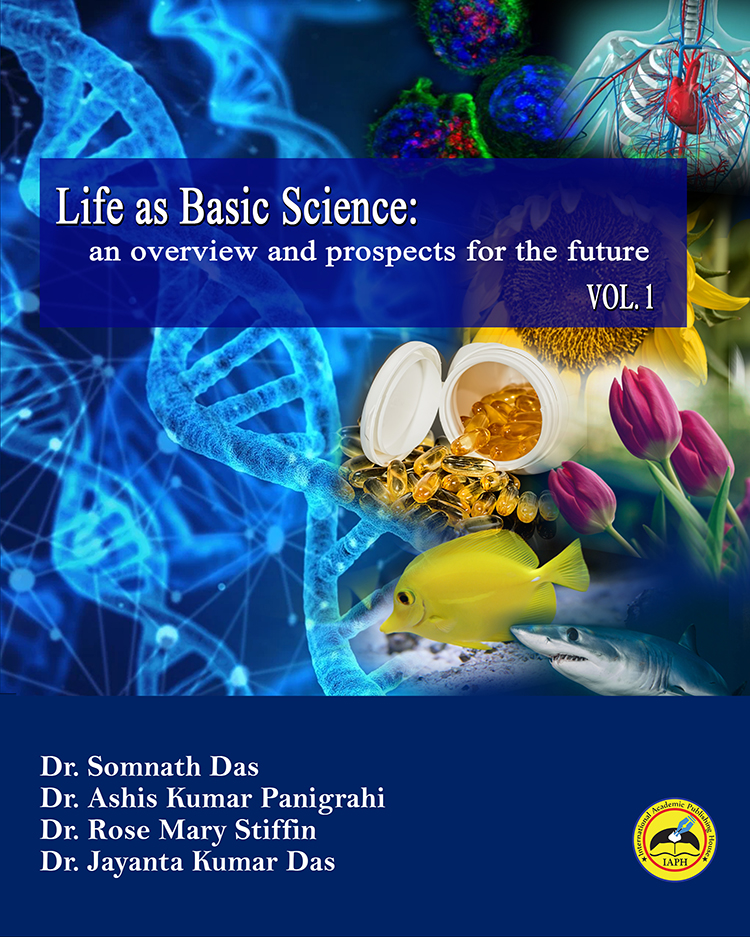Evaluation of Biochemical Changes of Benzo (A) Pyrene Induced Lung Carcinogenesis in Vivo and its Prevention by Vesicular Drug Targeting
Sunit Kumar Chakraborty
Department of Zoology, Raja Rammohun Roy Mahavidyalaya, Radhanagar, Nangulpara, Hooghly- 712406, West Bengal, India
DOI: https://doi.org/10.52756/lbsopf.2024.e01.013
Keywords: Benzo(a)pyrene, ROS, Biochemical changes, lung carcinogenesis, prevention by liposomal Curcumin
Abstract:
Lung cancer is the leading cause of cancer mortality world-wide. Cigarette smoking is the most established risk factor for lung carcinogenesis; however, the effects of benzo (a) pyrene [B(a)P], one of the key carcinogens in smoke, on the progression of lung cancer are obscure. The identification of key regulatory and molecular mechanisms involved in lung carcinogenesis is, therefore, critical to understanding this disease and could ultimately lead to targeted therapies to improve prevention and treatment. In an earlier study, I observed the effect of curcumin on the changes in the activities of endogenous antioxidants and lipohydroperoxide in rat lung injury by the administration of B(a)P. In the present study, I am interested in investigating whether B(a)P produces ROS, which activates inflammatory mediators and Wnt/β-catenin signaling to produce a lot of transcriptional genes and biochemical changes involved in lung carcinogenesis and its mechanistic prevention by the targeting of liposomal curcumin in rat.
References:
- Ahmedin, J., Rebecca, S., Elizabeth, W., Yongping, H., Jiaquan, X., & Michael, JT. (2009). Cancer Statistics. CA Cancer J Clin., 59, 225- 249.
- Biesalski, HK., Bueno de Mesquita, B., & Chesson, A. et al (1998). European consensus statement on lung cancer: risk factors prevention. CA Cancer J Clin., 48(3), 167- 176.
- Boga, I., & Bisgin, A. (2022). Real-world applications of tumor mutation burden (TMB) analysis using ctDNA and FFPE samples in various cancer types of Turkish population. Int. J. Exp. Res. Rev., 29, 89-93. https://doi.org/10.52756/ijerr.2022.v29.010
- Chyou, PH., Nomura, AM., & Stemmermann, GN. (1992). A prospective study of the attributable risk of cancer due to cigarette smoking. Amer J Public Health., 82, 37- 40.
- Dey, S., & Guha, P. (2020). A brief review on cigarette induced cellular. Int. J. Exp. Res. Rev., 23, 18-26. https://doi.org/10.52756/ijerr.2020.v23.002
- Field, AW., Krewski, D., & Lubin, JH et al (2006). An overview of the North American residential random and lung cancer case-control studies. J Toxicol Environ Hlth Part A., 69, 599- 631.
- Gelboin, HV. (1980). Physiol Rev., 60, 1107- 1166.
- Hoffmann, D., & Hecht, SS. (1990). Advances in tobacco carcinogenesis. In handbook of experimental pharmacology. Edited by: Cooper CS, Grover PL. Heidelberg (Germany): Springer- Verlag., 94/1, 63- 102.
- Hoffmann, D., & Hoffmann, I. (1997). The changing cigarette, 1950- 1995. J Toxicol Environ Health., 50, 307- 364.
- Madhu, N.R., Sarkar, B., Biswas, P., Roychoudhury, S., Behera, B.K., & Acharya, C.K. (2023). Therapeutic potential of melatonin in glioblastoma: Current knowledge and future prospects. Biomarkers in Cancer Detection and Monitoring of Therapeutics, Volume-2. Elsevier Inc., 371-386. ISBN 978-0-323-95114-2. https://doi.org/10.1016/B978-0-323-95114-2.00002-9
- Madhu, N.R., Sarkar, B., Roychoudhury, S., & Behera, B.K. (2022). Melatonin Induced in Cancer as a Frame of Zebrafish Model. © Springer Nature Singapore Pte Ltd. 2022, S. Pathak et al. (eds.), Handbook of Animal Models and its Uses in Cancer Research., pp. 1-18. ISBN: 978-981-19-1282-5 https://doi.org/10.1007/978-981-19-1282-5_61-1
- Maiti, S., & Chatterjee, AK. (2000). Differential response of cellular antioxidant mechanism of liver and kidney to arsenic exposure and its relation to dietary protein deficiency. Environ Toxicol Pharmacol., Jun 1;8(4), 227- 235.
- Maiti, M., & Samanta, G. (2018). Relationship between physical activity and smoking behavior among college students. Int. J. Exp. Res. Rev., 15, 39-43. https://doi.org/10.52756/ijerr.2018.v15.006
- Mehta, V., Dey, A., Thakkar, N., Prabhakar, K., Jothimani, G., & Banerjee, A. (2023). Anti-cancer Properties of Dietary Supplement CELNORM against Colon and Lung Cancer: An in vitro preliminary study. Int. J. Exp. Res. Rev., 32, 1-14. https://doi.org/10.52756/ijerr.2023.v32.001
- Mukherjee, Nee., Chakraborty, S., Ghosh, U., Bhattacharyya, NP., Bhattacharya, RK., Dey, S., & Roy, M. (2007). Curcumin-induced apoptosis in human leukemia cell HL-60 is associated with inhibition of telomerase activity. Mol Cell Biochem., 297, 31- 39.
- Parkin, DM., Laara, E., & Muir, CS. (1988). Estimates of the world-wide frequency of sixteen major cancers in 1980. Int J Cancer., 41, 184- 193.
- Peto, RR., Lopez, AD., & Boreham, J. et al 2006. Mortality from smoking in developed countries 1950- 2000: Indirect estimates from National vital statistics. Oxford University Press.
- Saha, A., & Yadav, R. (2023). Study on segmentation and prediction of lung cancer based on machine learning approaches. Int. J. Exp. Res. Rev., 30, 1-14. https://doi.org/10.52756/ijerr.2023.v30.001
- Su, CC., Chen, GW., Lin, JG., Wu, LT., & Chung, JG. (2006). Curcumin inhibits cell migration of human colon cancer colo 205 cells through the inhibition of nuclear factor kappa B/p65 and down regulates cyclooxygenase-2 and matrixmetalloproteinase-2 expressions. Anticancer Res, 26, 1281- 1288.
- WHO (February 2006). Cancer. World Health Organisation. http://www.who:int/mediacentre/factsheets/fs297/en/. Retrieved 2007 – 06- 25. Wynder, EL., & Hoffmann, D. (1994). Smoking and lung cancer: Scientific challenges and opportunities. Cancer Res., 54, 5284- 5295.

How to Cite
Sunit Kumar Chakraborty⃰ (2024). Evaluation of Biochemical Changes of Benzo (A) Pyrene Induced Lung Carcinogenesis in Vivo and its Prevention by Vesicular Drug Targeting. © International Academic Publishing House (IAPH), Dr. Somnath Das, Dr. Ashis Kumar Panigrahi, Dr. Rose Stiffin and Dr. Jayata Kumar Das (eds.), Life as Basic Science: An Overview and Prospects for the Future Volume: 1, pp. 165-171. ISBN: 978-81-969828-9-8 doi: https://doi.org/10.52756/ lbsopf.2024.e01.013
SHARE WITH EVERYONE
